The incident of radioactive source loss at the Rare Nuclear Technology Institute was promptly addressed, yet it still caused public concern. Mr. Dang Thanh Luong, Deputy Head of the Department of Radiation and Nuclear Safety, discussed with VnExpress the management processes and how to identify radioactive sources.
– How is radiation safety management conducted at facilities?
|
The Ministry of Science and Technology has imposed a fine of 44 million VND on the Rare Nuclear Technology Institute for the radioactive loss incident. The institute has also been suspended from operations for three months. (According to Lao Dong) |
The Department of Radiation and Nuclear Safety is currently responsible for licensing and managing all radioactive sources nationwide (except for about 2,000 medical X-ray machines licensed by local Departments of Science and Technology). Radioactive sources are materials that continuously emit ionizing radiation. X-ray machines emit radiation only when powered on and activated. Therefore, radioactive sources are managed very strictly, requiring licenses for all stages: from importation into Vietnam (or production if domestically sourced) to trading, transportation, use, storage, and permanent disposal. If a radioactive source has been used and becomes waste but is still stored, it is still considered an asset of the agency and remains under state management. The department must manage records and conduct regular inspections. Currently, in Vietnam, the process of permanent disposal has not yet been implemented, and storage is still the current step, so the responsibility for the management and inventory of radioactive sources lies with the facility owners.
According to the 1996 Radiation Safety and Control Ordinance, each facility must have a person responsible for radiation safety. In addition to the licensing documents submitted to the department, they must have declarations of the radiation sources and relevant certifications, a safety assessment report of the facility, and training certificates in radiation safety (retrained every three years), along with an emergency response plan, especially for facilities with relatively high radiation sources. After the 9/11 terrorist attacks in the U.S., we required facilities to enhance security measures for radioactive sources (against theft, vandalism, terrorism…).
– With such strict management procedures, why did an incident occur at the Rare Nuclear Technology Institute recently?
The Department of Radiation and Nuclear Safety has the general responsibility for management and supervision to ensure facilities comply with laws. However, the responsibility for ensuring safety lies with the facility owner (according to Decree 50/1998/ND-CP). All radioactive sources pose safety risks, especially those that can be easily dismantled, frequently moved, or inadequately stored. Fixed sources are generally harder to lose. The recent loss of a radioactive source at the Rare Nuclear Technology Institute occurred because there was no supervision over unauthorized individuals entering the facility, particularly in areas where radioactive sources were stored, allowing the source to be stolen. The highest responsible person here is the director of the institute.
– What lessons has the Department learned from the incident regarding radioactive source management?
Addressing the incident is just one part of the solution. The lesson from this case is the continuous enhancement of safety culture for everyone, from managers to users and the general public. It is essential to understand that not only high radiation sources pose dangers but also low radiation sources. Neglecting management at any stage can lead to safety hazards, affecting public psychology. Furthermore, we recognize that the responsibility of the radiation safety officer at a facility, regardless of size, is crucial. The safety officer must be granted sufficient authority by the facility owner to independently handle situations to ensure safety. For example, if they detect violations or potential radiation safety risks, they have the authority to shut down production lines, regardless of pressure from the facility owner. Another lesson is the importance of being prepared for emergencies. This readiness must be maintained, similar to fire prevention systems.
– In addition to properly documented radioactive sources, Vietnam also has orphan radioactive sources. How are they currently managed?
Orphan radioactive sources are those that have never been managed by state regulatory agencies for various reasons. These include sources that have been stolen or lost without the facility’s knowledge, or sources that have been left over from the war, or radioactive materials mixed in scrap metal imported into Vietnam… These also pose risks to society. We are developing regulations to manage these sources, starting with guidelines for facilities on waste handling, waste classification, or how steel processing plants can detect them.
We encourage metal recyclers to implement measures to promptly detect radioactive sources to avoid melting them down, which could cause immeasurable harm to their facility, the environment, and the public. Citizens are encouraged to report any suspicions or discoveries to regulatory agencies promptly.
– How can the public identify a radioactive source?
The public must raise awareness, especially those who are most likely to come into contact with radioactive sources, such as scrap collectors. Previously, the department distributed flyers on how to identify radioactive sources, but it was limited, mainly for those attending training. After this incident, the department will enhance awareness-raising efforts for every citizen through media channels, brochures, and especially via the website http://www.varansac.org.vn.
 |
|
Signs of radioactive sources. |
A simple way to identify radioactive sources is: Usually, radioactive sources are contained in heavy, sealed blocks, marked with a star symbol or labeled with the word “Radioactive.” If all signs are missing but you see a very heavy spherical, cylindrical, or elliptical block (often containing lead), do not attempt to break it open, but consult with responsible authorities. If you discover such unusual blocks, the public should call the Departments of Science and Technology, the police, or directly contact the Department at the following numbers: 04 8220298; 04 9365233; 04 9365234.
Regarding the health of those who have been exposed to radioactive sources, Master Nguyen Xuan Cu, Head of the Radiation Physics Department at K Hospital, believes the degree of harm depends on the radiation intensity, distance, and duration of exposure. For high radiation sources, individuals who are close or exposed for long periods can suffer immediate harm or even death. Conversely, it may take months, years, or even many years for health issues to emerge. Therefore, after exposure to a radioactive source, if health examination results are completely normal, it does not guarantee that the individual has not been affected.
Individuals exposed to radioactive sources need to be monitored for their health over a long period, with multiple tests, especially blood parameters such as red blood cells, white blood cells, chromosome testing…
Thuan An

















































